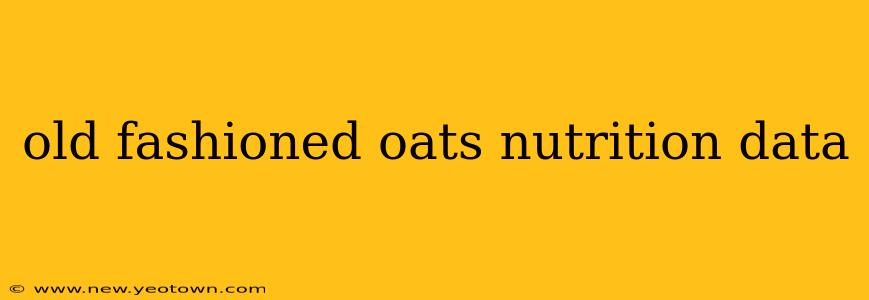Old-fashioned oats, also known as rolled oats, are a breakfast staple for many, but their nutritional benefits often go unnoticed. Let's delve into the hearty goodness of this humble grain and uncover why it deserves a prominent place in your diet. Forget the sugary, processed cereals; let's talk about the real deal—the wholesome goodness of old-fashioned oats.
My grandmother used to tell me stories about her childhood, where a simple bowl of oatmeal was a daily ritual, fueling her through long days of work on the farm. And while times have changed, the enduring nutritional value of old-fashioned oats remains a constant.
What Makes Old-Fashioned Oats So Nutritious?
Old-fashioned oats are packed with essential nutrients that contribute to overall health and well-being. They're a fantastic source of:
-
Fiber: This is arguably their most significant benefit. Fiber aids digestion, promotes regularity, and helps you feel fuller for longer, assisting with weight management. It's also crucial for maintaining healthy cholesterol levels.
-
Protein: Oats provide a decent amount of plant-based protein, essential for building and repairing tissues. While not a primary protein source, it adds to your daily intake, especially beneficial for vegetarians and vegans.
-
Vitamins and Minerals: They contain various vitamins and minerals, including manganese, magnesium, phosphorus, and selenium – all vital for numerous bodily functions.
-
Antioxidants: Oats are rich in antioxidants, which help protect your cells from damage caused by free radicals. This contributes to overall health and reduces the risk of chronic diseases.
Are Old-Fashioned Oats Better Than Other Oats?
This is a question frequently asked, and the answer is nuanced. Old-fashioned oats are minimally processed, retaining more of their nutritional value compared to quick-cooking or instant oats. These latter varieties undergo more processing, which can reduce the fiber content and some nutrients. However, the difference isn't always dramatic; it simply depends on your priorities.
How Many Calories Are in Old-Fashioned Oats?
The calorie count in old-fashioned oats varies depending on the serving size and any added ingredients. A typical half-cup (dry) serving contains roughly 150 calories. Remember, this is just the oats themselves; adding milk, sugar, or fruit will significantly increase the calorie count.
What Are the Health Benefits of Eating Old-Fashioned Oats?
The benefits extend beyond just the nutritional profile:
-
Improved Heart Health: The soluble fiber in oats helps lower LDL ("bad") cholesterol, reducing the risk of heart disease.
-
Better Blood Sugar Control: The fiber slows down the absorption of sugar into the bloodstream, helping to regulate blood sugar levels, particularly beneficial for individuals with diabetes or prediabetes.
-
Weight Management: The high fiber content promotes satiety, keeping you feeling full and potentially aiding in weight loss or maintenance.
-
Improved Digestion: The fiber content also supports a healthy digestive system, preventing constipation and promoting regularity.
What is the Difference Between Old-Fashioned Oats and Steel-Cut Oats?
This is another common query. While both are whole-grain oats, steel-cut oats are less processed, resulting in a chewier texture and slightly longer cooking time. Nutritionally, they are very similar, though steel-cut oats might retain slightly more fiber.
How to Incorporate Old-Fashioned Oats into Your Diet
Old-fashioned oats are incredibly versatile. They're not just for breakfast! Here are a few ideas:
-
Oatmeal: The classic way, whether you prefer it creamy or with a bit of chew.
-
Baked Goods: Add them to muffins, cookies, or bread for added fiber and texture.
-
Smoothies: Blend them into your favorite smoothie for a nutritional boost.
-
Savory Dishes: Use them as a thickening agent in soups or stews.
In conclusion, old-fashioned oats are a nutritional powerhouse packed with fiber, protein, vitamins, and minerals, offering numerous health benefits. They’re a versatile ingredient easily incorporated into a variety of dishes, making them a smart and delicious addition to any healthy diet. So next time you're planning your meals, remember the humble, yet mighty, old-fashioned oat.

